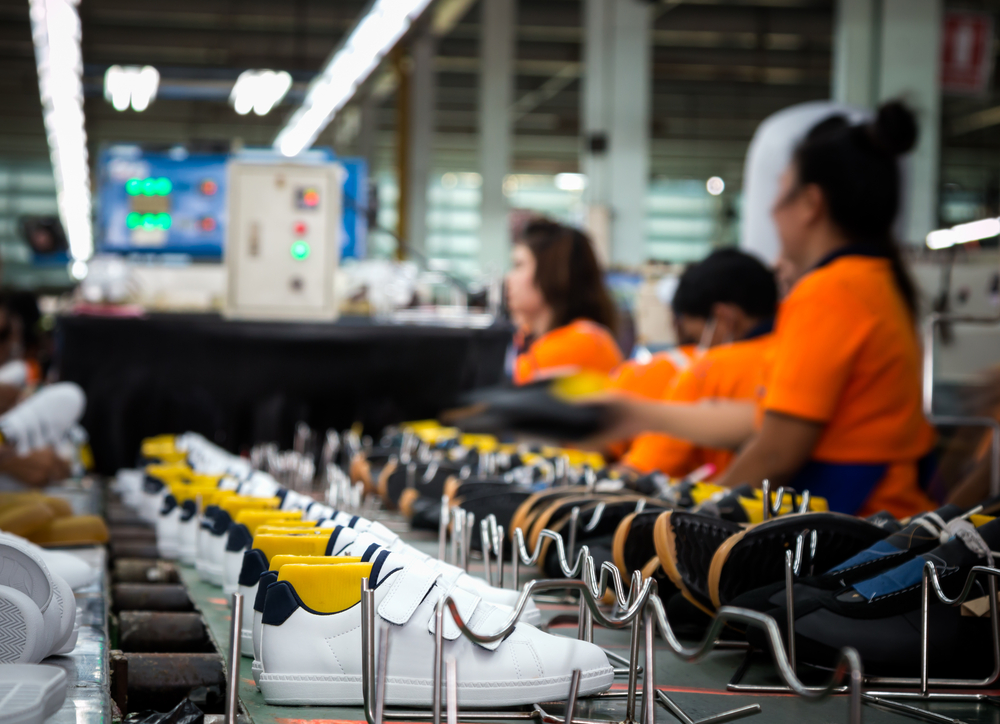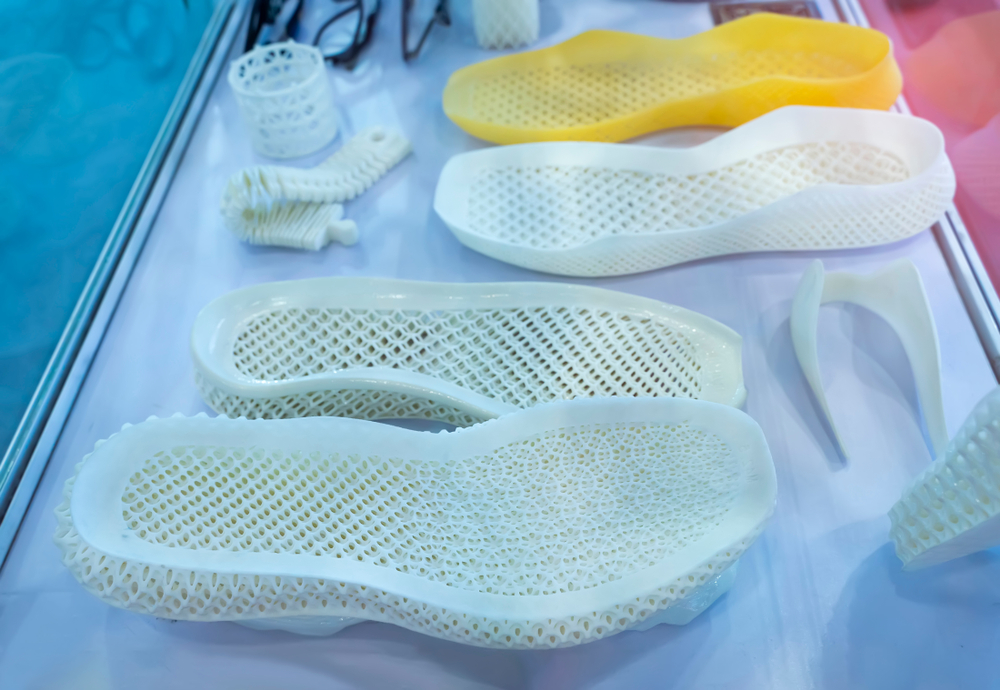
Footwear manufacturing is a labor-intensive industry. Insoles, midsoles, heels, and uppers are frequently separately created and then glued or stitched together by workers on an assembly line. Shoe factory production lines will employ 100+ laborers to maximize output. Western companies outsource footwear manufacturing to China, India, Vietnam, and other countries to reduce labor costs. With lengthy prototyping and testing phases, developing footwear can take 18 to 24 months to market.
In recent years, advancements in 3D printing technology are streamlining the manufacturing process. Footwear companies are leveraging 3D printers to optimize operations, enabling fully-functional prototypes and increased design freedom. 3D printing improves the footwear manufacturing process with greater automation, and 3D printed footwear is projected to globally generate over USD 1 billion by 2023 and USD 6.5 billion by 2029.
How to Implement 3D Printing in the Footwear Manufacturing Processes
Modern shoe production is a multi-step process that requires high labor costs and long product testing stages. Manufacturers use injection molding machines and sole cementing systems to accelerate production and reduce labor costs. However, production time and effort are still high.
The footwear industry is adopting 3D printers to reduce time to finalize designs for production, streamlining and simplifying manufacturing:
Fully-Functional Prototypes to Streamline the Testing Phases
Traditional methods for footwear prototyping is often a long and manual process with many steps. Prototyping can consist of multiple prototypes, such as proof of concept, aesthetic or visual, and functional, including experience. Proof of concepts investigate new manufacturing methods or new materials, aesthetic prototypes examine size and appearance, and functional prototypes explore the design’s function.
Fully functional prototypes will embody both function and design and are close to the final product. Often made with a different method from the final design, functional prototypes are costly and time consuming to create. Footwear companies will limit the number of sample prototype models that demonstrate different color, weight, or fit. Making them overseas takes weeks for contract manufacturers to create and ship prototypes to designers. After reviewing the models, designers send feedback to the manufacturer that are incorporated into the next model. It may take months to finalize the model.
3D printers not only shorten the prototyping process, but they can also accelerate the production process. Advanced 3D printers can print fully-functional prototypes and production products. Using the same process to make prototypes and the finished product, companies can reduce manufacturing risk and minimize production time. The prototype models are made with production-ready materials and can immediately undergo field testing. With 3D printing, taking a footwear product from sketch to production-ready can take as little as three weeks.
Reducing Labor With Part Consolidation
When taking a product from prototype to production using traditional methods, a design may need to be broken down into sub-parts for ease of manufacturing or to achieve specific mechanical performance. It can require a series of redesigns and multiple materials to achieve the necessary shoe performance and accommodate tooling constraints. Multiple sub-parts complicates the assembly of the final product. It also lengthens the time to bring a product to market, limits designs, and requires additional labor to assemble the sub-parts.
Using 3D printers, companies can create more complex geometries and tune performance utilizing a single material—reducing or eliminating assembly steps and simplifying the manufacturing process. For instance, in footwear, a shoe design can contain over ten components that are injection molded, stitched, and glued together. 3D printing reduces the ten components to two. 3D printing or knitting can be used as an entire shoe upper, eliminating stitching steps required to assemble traditional upper designs containing multiple components. 3D printed soles can replace the foam midsole and rubber outsole with one part, eliminating injection molding tooling for both the midsole and outsole for each shoe size.
In some instances, 3D printing can further consolidate parts by enabling manufacturers to print an entire shoe in one step. The approach eliminates all tooling and assembling steps and allows the footwear industry to adopt an on-demand and automated footwear manufacturing business model.
3D Printing: The Future of Footwear Manufacturing Automation

3D printing technologies can get products to market faster than traditional methods by reducing steps and automating footwear manufacturing. The future of 3D printing in footwear manufacturing will be driven by:
Global 3D Printing Smart Factories
Smart factories are incorporating 3D printing, automation, and artificial intelligence technologies. By automating footwear manufacturing, smart factories deliver footwear with significantly less labor than traditional manufacturing facilities, allowing greater flexibility where footwear production can occur, including regions with high labor costs.
With no tooling requirement, a smart factory can better meet on-demand manufacturing needs. Companies that incorporate smart factories into their manufacturing strategies can more easily address peak demand instead of expanding or building more manufacturing sites to increase output. As more smart factories are located worldwide, companies can leverage them to reduce supply chain, trade, or tariff risk.
Smart Factory Connected 3D Printers
Smart factory connected 3D printers have direct access to a smart factory through the cloud. It enables designers to make swift changes, finalizing designs on their local 3D printer, and then connect to a smart factory for instant manufacturing. With the same 3D printer, production method, and materials for prototypes and production, designers do not need to test performance or validate the smart factory’s design. Companies can go from low to high volume manufacturing with on-demand production capacity. By partnering with a smart factory, footwear manufacturers achieve the following:
- Faster time to market: 3D printers use the same processes to prototype goods as they manufacture them. As soon as you finalize your design, smart factories provide instant access to scale. The increased localization of the facilities also cuts down on shipping times, further accelerating product turnaround time.
- Greater inventory control: Typically, contract manufacturers require high minimum order quantities (MOQs) to reduce investment risk from tooling costs. These MOQs limit the number of designs a brand can bring to market and often far exceed the market demand for a given design, leading to overstock. Smart factories have more flexibility as there are no tooling costs, and one printer can produce multiple products.
- Swift market responses: The on-demand printing capabilities of smart factories enable companies to respond to market demands quickly. If more product is needed or redesigns necessary, smart factories would allow manufacturers to respond to spikes in demand and enable more frequent design refreshes. Companies can be more agile than if they used traditional manufacturing facilities.
Personalized Aesthetics and Customized Fits
Automated footwear manufacturing enabled by 3D printing and the footwear manufacturing workflow’s digitalization creates a powerful platform to support personalized designs and customized fit.
- Personalized design: 3D printing gives designers and consumers unprecedented freedom to achieve unique designs personalized to individual preferences. Possibilities enabled by this technology include:
- Individualized design flexibility: 3D printing combined with user-friendly software allows designers to develop more SKUs with unique combinations of colors, textures, accessories, structures, etc.
- Customer as the designer: Digitalized workflow combined with automated footwear manufacturing gives design control to the consumer. Brands can allow consumers to select everything from shoe color to texture or patterns and personalized accessories, creating a one-of-a-kind product.
- Customized fit:
- Digitalized workflow enabling customization: 3D scanners would allow brands to scan their customer’s feet. These scans convert into CAD models and digitally tune to each individual’s unique shape, size, and mechanical requirements to ensure comfort and performance. When the design is complete, the individually tuned footwear CAD files are electronically sent to the smart factory for production, packaging, and shipping to the consumer. For orthopedic patients, shoes can now essentially operate as built-in orthotics, while runners can find the perfect fit for their type of foot.
Automate Your Footwear Manufacturing Operation with a 3D Printing Partner
There will be a rapid growth of 3D printed footwear over the next decade with greater demand for a better fit, longer life, higher performance, and greater design freedom. 3D printing streamlines prototyping through production and enables more complex designs with easier or no assembly. As the industry shifts to support personalized and custom footwear, 3D printing is essential for companies to create fully customizable product lines and quickly respond to market demand.
To learn more about leveraging 3D printing to automate footwear manufacturing, visit our contact page or call (650) 336-0888.
